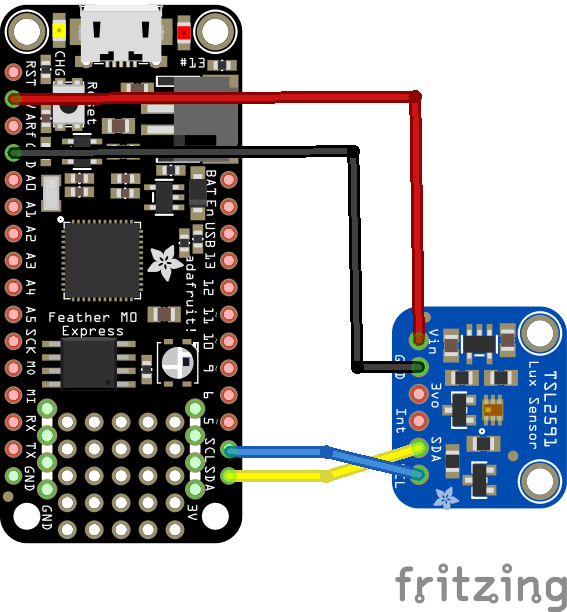In this example we connect a TSL2591 light-to-digital converter to an Adafruit Feather M0 running Circuitpython
The TSL2591 is a very high sensitivity light-to-digital converter that transforms light intensity into a digital signal output capable of direct I2C interface. The device combines one broadband photodiode (visible plus infrared) and one infrared-responding photodiode on a single CMOS integrated circuit. Two integrating ADCs convert the photodiode currents into a digital output that represents the irradiance measured on each channel.
This digital output can be input to a microprocessor where illuminance (ambient light level) in lux is derived using an empirical formula to approximate the human eye response. The TSL2591 supports a traditional level style interrupt that remains asserted until the firmware clears it.
Features
- Highest sensitivity to 188µLux
- Patented dual-diode architecture
- 600M:1 dynamic range
- Programmable interrupt function
- UV-rejection package
Product parameters
| Supply Voltage [V] | 2.7 – 3.6 |
|---|---|
| Interface | I2C – VDD |
| Programmable | Gain, integration time, interrupt |
| Max. Lux | 88000 |
| Temperature Range [°C] | -30 to 70 |
This is the sensor I purchased, link below
Parts List
| Name | Link |
| Adafruit Feather M0 Express | Adafruit (PID 3403) Feather M0 Express – Designed for CircuitPython – ATSAMD21 Cortex M0 |
| TSL2591 | TSL2591 Optical Light Sensor Development Board |
| Connecting cables | Free shipping Dupont line 120pcs 20cm male to male + male to female and female to female jumper wire |
Connection

feather and tsl2591
Code
I used Mu for development as per Adafruit’s advice
The following is based on a library , I copied the TSL2591 library to the lib folder to my Feather M0 Express – https://circuitpython.org/libraries
[codesyntax lang=”python”]
# Simple demo of the TSL2591 sensor. Will print the detected light value
# every second.
import time
import board
import busio
import adafruit_tsl2591
# Initialize the I2C bus.
i2c = busio.I2C(board.SCL, board.SDA)
# Initialize the sensor.
sensor = adafruit_tsl2591.TSL2591(i2c)
# Read the total lux, IR, and visible light levels and print it every second.
while True:
# Read and calculate the light level in lux.
lux = sensor.lux
print("Total light: {0}lux".format(lux))
# You can also read the raw infrared and visible light levels.
# These are unsigned, the higher the number the more light of that type.
# There are no units like lux.
# Infrared levels range from 0-65535 (16-bit)
infrared = sensor.infrared
print("Infrared light: {0}".format(infrared))
# Visible-only levels range from 0-2147483647 (32-bit)
visible = sensor.visible
print("Visible light: {0}".format(visible))
# Full spectrum (visible + IR) also range from 0-2147483647 (32-bit)
full_spectrum = sensor.full_spectrum
print("Full spectrum (IR + visible) light: {0}".format(full_spectrum))
time.sleep(1.0)
[/codesyntax]
Testing
Here is what I saw in Mu REPL window
Total light: 1.18157lux
Infrared light: 9
Visible light: 589837
Full spectrum (IR + visible) light: 589846
Total light: 1.01837lux
Infrared light: 9
Visible light: 589836
Full spectrum (IR + visible) light: 589845





